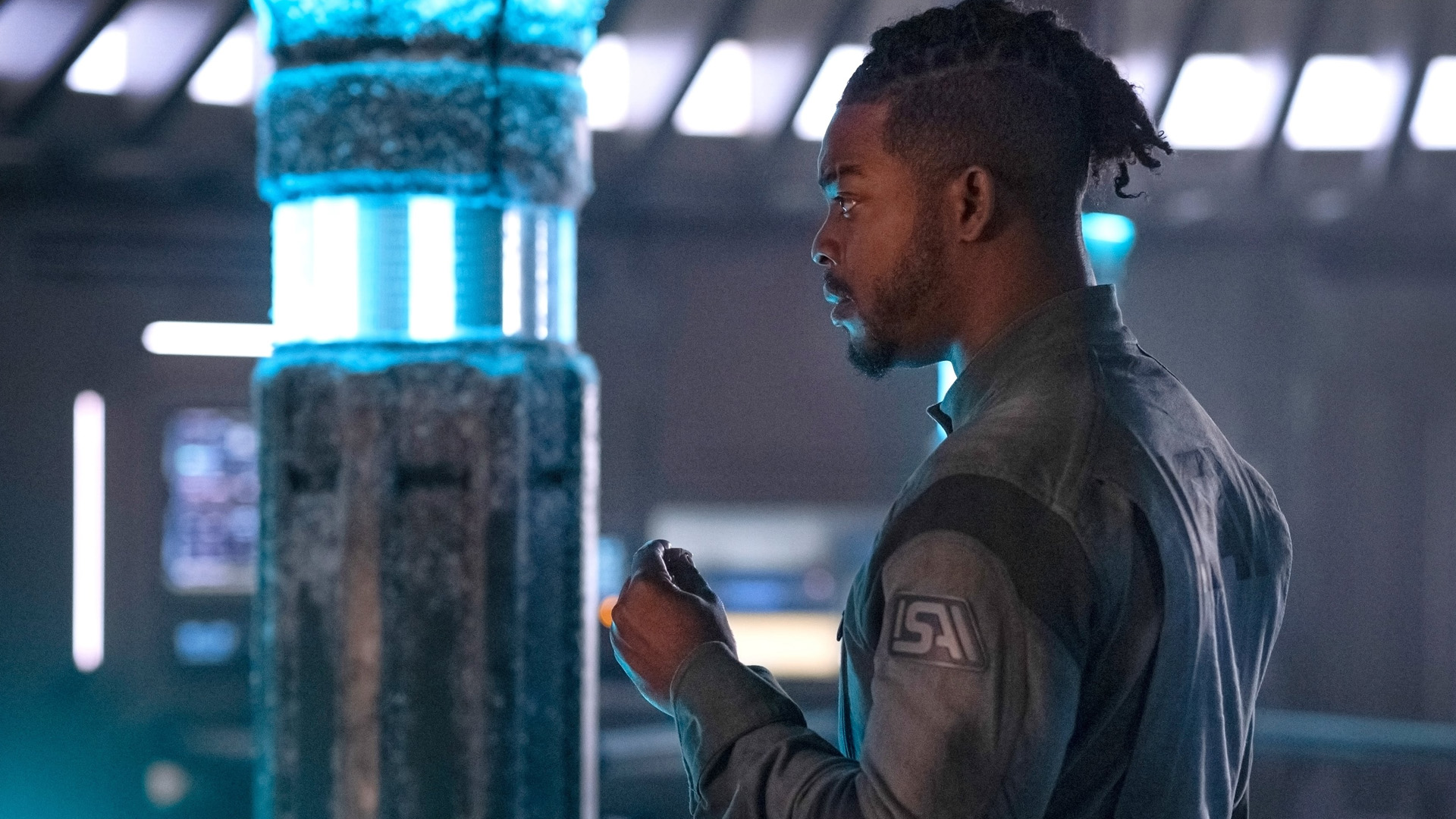Beacon 23’s new eps offer more tense, thoughtful sci-fi drama from the author of Silo

A cerebral sci-fi series set in a spaced-out 23rd Century lighthouse returns with season two of Beacon 23. The new episodes deliver even more thoughtful sci-fi twists, surprising turns, and dark drama, writes Adam Fresco.
“It’s about a lighthouse-keeper, only in space!” At least that’s how I guess the initial elevator pitch went for Beacon 23—and as concepts go, that’s a pretty intriguing premise. Like the first season, this second sojourn into deep space doesn’t mess about in establishing its plot and characters, plunging audience members straight into the 23rd Century, with a deft touch and an engaging sense of mystery. That’s not surprising, as series creator and showrunner Zak Penn was co-writer of Marvel’s smash hit movie The Avengers and adapted Ready Player One from the novel to the screen for Steven Spielberg.
Penn is not the only key creative involved with an impressive resume when it comes to sci-fi because, like Silo, this is a show based on the work of author Hugh Howey. As with Silo, Howey’s Beacon 23 exploits one main claustrophobic location to maximum effect, leveraging the isolation to ramp up a creeping sense of tension, doused in dread.
In a war-scarred future, ships travel faster than the speed of light. What allows them to manoeuvre safely across the Milky Way at high velocity is a network of invulnerable beacons set amidst a freezing universe full of fast-moving chunks of ice, rock, and assorted space debris. Invulnerable—until of course they’re not. Which poses quite the challenge to soldier and now Beacon Keeper, Halan. He’s an antihero played with suitable angst by Stephan James, who featured in movies Selma and 21 Bridges, and does a superb job playing a guy who might just be losing his mind.
![]()
If the Beacon playing up and ships in distress aren’t enough weight for Halan’s fragile shoulders, there’s the loneliness, and ever-present threat of madness that accompanies being stuck about as far away from humanity as it’s possible to be. Not to mention dastardly scavengers, devious governmental forces, and the myriad dangers of surviving in deep space. And aliens. Did I mention aliens?
While this is no action-heavy, CGI-battle filled drama, it does deliver on thoughtful science-fiction themes of humanity surviving against all odds in the solitary confines of space. Stephan James makes an ideal Halan, a character haunted by a past war and his present solitude. But he’s not alone for long in season one. Following a shipwreck, mysterious government agent Aster joins Halan, claiming she is on a mission seeking to find samples of a certain rock. But it’s hard to trust a word she says.
![]()
That mistrust might well be informed by the fact that Aster is played by Lena Headey, whose past roles include the wickedly watchable Cersei Lannister in TVs Game of Thrones, as well as Ma-Ma, ruthless nemesis to Karl Urban’s Judge Dredd in Dredd. Headey makes a fitting co-star, her past roles messing with our preconceptions as to her character’s true intent. Is Aster who she claims to be? Or are there more sinister motives at play? Reinforcing the viewer’s uncertainty, neither Aster nor Halan trust one another, and whilst their extreme circumstances force them to collaborate, there’s always doubt, and a dark cloud obscuring the truth.
It’s a great set-up for a drama that relies on keeping audiences constantly guessing, never quite knowing which way is up in the claustrophobic confines of the far-flung twenty-third space beacon. The growing sense of dread is expertly conducted by the show’s makers who, as they did in season one, continue to throw crisis after catastrophe at Halan and Aster, in a bid to keep them, and us, in a perpetual state of edge-of-the-seat suspense. From space pirates, terrorists, sinister government agents, possible alien lifeforms, and natural catastrophes, I haven’t been this invested in sci-fi castaways since Adama and his crew played their tense game of spot-the-Cylon in Ronald D. Moore’s Battlestar Galactica reboot.
![]()
The first season focused on Aster’s search for the mystery mineral—but what is it? A virus? An alien? Intelligent? Benign? Or deadly? Who knows, but the excrement really hit the proverbial fan with the arrival of an object known as “The Artifact”. It all came to a head in the final season one episode, when Aster attempted to communicate with The Artifact, only for proceedings to end on a great cliffhanger that left fans keen for more.
The second season kicks off with attempts to commune with The Artifact. I don’t want to reveal the secrets in store, but the new season does a bang-up job of building on the characters, stories, and mysteries of the first, as Halan tries to reconcile his past traumas with an ever-increasing desperation to escape the confines of Beacon 23, and the various individuals and organisations vying for control of The Artifact. This second helping of cerebral sci-fi delivers on the promise of the first, with tighter plotting, great characters, and a more focused narrative that makes this by far the better of the two seasons.
Backing up Headey and James’ crackling onscreen chemistry are a first-rate cast, because whilst Beacon 23 may be set on a lonely outpost in the far reaches of the Milky Way, they get more than enough visitors to keep the guest stars a-coming. Alongside the two leads are their personal Artificial Intelligent aides, with Wade Bogert-O’Brien as the voice of Bartholomew, Halan’s creepy computerised companion, and Natasha Mumba as Aster’s A.I. sidekick, Harmony.
![]()
The show’s steady pace might not immediately satisfy those seeking explosive, high-octane sci-fi action. But those willing to let the story settle and give in to its incremental charms will be rewarded with sci-fi drama more akin to the aforementioned Silo, or the Ridley Scott-produced series Raised By Wolves, than the slam-bang-and-blast of an Independence Day-style sci-fi popcorn-cruncher.
Like the first, this new season requires a viewer who is ready to be actively engaged in the machinations of the twisting tale, but if you like your sci-fi moody and measured, Beacon 23 has a lot to offer. Taut as Chewbacca’s bowcaster, it’s adult science-fiction that entertains the brain, as it ponders issues resulting from PTSD, devastating solitude, and maddening uncertainty, in a world fraught with unseen dangers, untrustworthy allies, and innumerable enemies.
If you stay the course through its first season and enjoy it as much as I did, you’ll be back for season two, and eight more heaped servings of spaced-out sci-fi. These new episodes deliver even more dark thoughtful twists, surprising turns, and dark drama from characters more complex and three-dimensional than your average intergalactic soap opera.


















